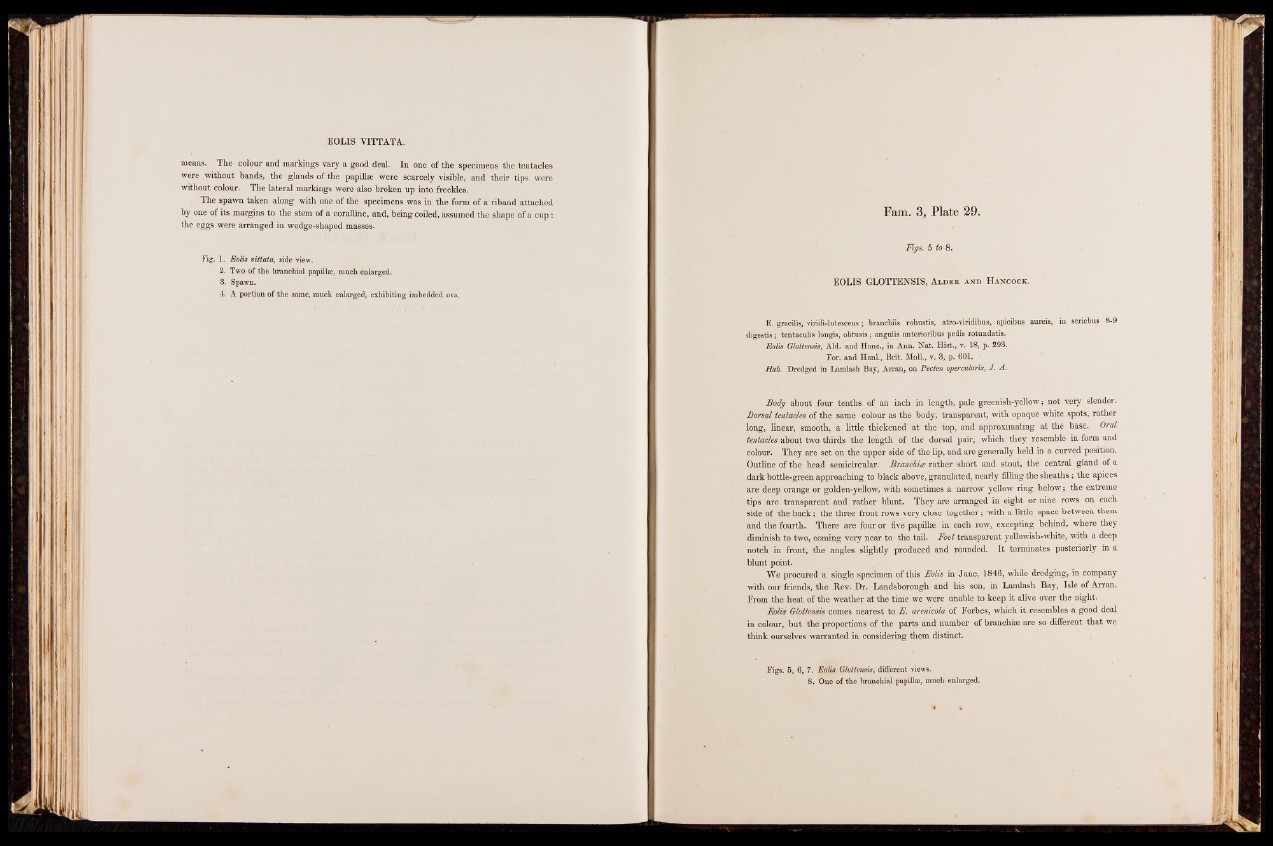
means. The colour and markings vary a good deal. In one of the specimens the tentacles
were without bands, the glands of the papillae were scarcely visible, and their tips were
without colour. The lateral markings were also broken up into freckles.
The spawn taken along with one of the specimens was in the form of a riband attached
by one of its margins to the stem of a coralline, and, being coiled, assumed the shape of a cup :
the eggs were arranged in wedge-shaped masses.
Fig. 1. Eolis vittata, side view.
2. Two of the branchial papillae, much enlarged.
3. Spawn.
4. A portion of the same, much enlarged, exhibiting imbedded ova.
EOLIS GLOTTENSIS, Alder and Hancock.
E. gracilis, viridi-lutescens; branchiis robustis, atro-viridibus, apicibus aureis, in seriebus 8-9
digestis; tentaculis longis, obtusis; angulis anterioribus pedis rotundatis.
Eolis Glottensis, Aid. and Hanc., in Ann. Nat. Hist., v. 18, p. 293.
For. and Haul., Brit. Moll., v. 3, p. 601.
Hab. Dredged in Tja.mla.sh Bay, Arran, on Pecten opercularis, J. A.
Body about four tenths of an inch in length, pale greenish-yellow; not very slender.
Dorsal tentacles of the same colour as the body, transparent, with opaque white spots, rather
long, linear, smooth, a little thickened at the top, and approximating at the base. Oral
tentacles■ about two thirds the length of the dorsal pair, which they resemble in form and
colour. They are set on the upper side of the lip, and are generally held in a curved position.
Outline of the head semicircular. Branchiae rather short and stout, the central gland of a
dark bottle-green approaching to black above, granulated, nearly filling the sheaths; the apices
are deep orange or golden-yellow, with sometimes a narrow yellow ring below; the extreme
tips are transparent and rather blunt. They are arranged in eight or nine rows on each
side of the back; the three front rows very close together; with a little space between them
and the fourth. There are four or five papillae in each row, excepting behind, where they
diminish to two, coming very near to the tail. Foot transparent yellowish-white, with a deep
notch in front, the angles slightly produced and rounded. It terminates posteriorly in a
blunt point.
We procured a single specimen of this Eolis in June, 1846, while dredging, in company
with our friends, the Rev. Dr. Landsborough and his son, in Lamlash Bay, Isle of Arran.
From the heat of the weather at the time we were unable to keep it alive over the night.
Eolis Glottensis comes nearest to E. arenicola of Forbes, which it resembles a good deal
in colour, but the proportions of the parts and number of branchiae are so different that we
think ourselves warranted in considering them distinct.
Figs. 5, 6, 7. Eolis Glottensis, different views.
8. One of the branchial papillae, much enlarged.